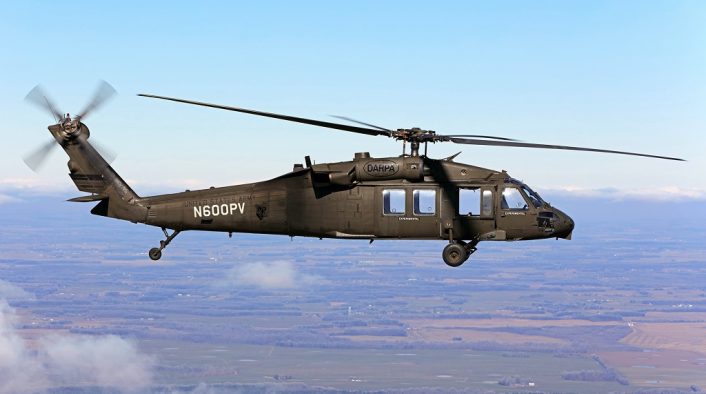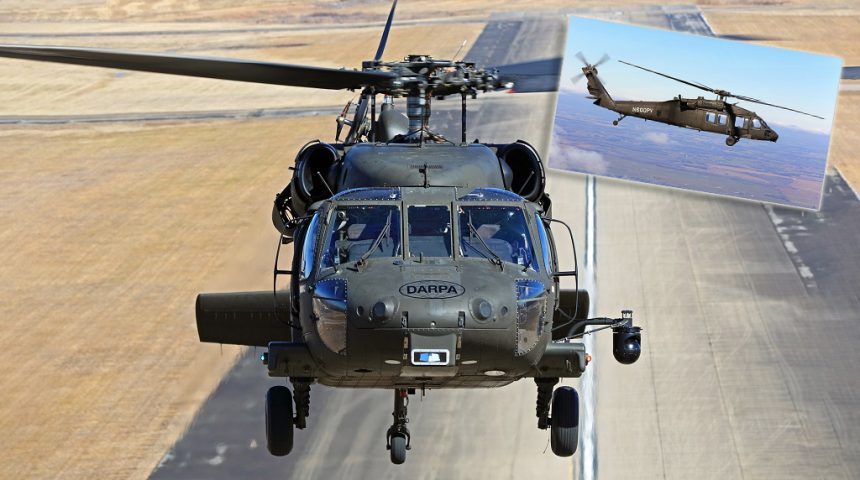The recent 30-minute flight is the result of Sikorsky’s and DARPA’s Aircrew Labor In-Cockpit Automation System (ALIAS) program.
Sikorsky and DARPA (Defense Advanced Research Projects Agency) announced the first unmanned flight of a UH-60A Black Hawk helicopter as part of the Aircrew Labor In-Cockpit Automation System (ALIAS) program. The helicopter, which has been retrofitted in an Optionally Piloted Vehicle (OPV) configuration, performed the 30-minute flight without anyone onboard on Feb. 5, 2022, over the U.S. Army installation at Fort Campbell (Kentucky), followed by a second flight on Feb. 7.
After preparing the Black Hawk, the pilot flipped the optionally piloted cockpit switch from two pilot operations to zero and left the aircraft. The helicopter then completed autonomously a pre-flight check list and started its engines in preparation for the flight. The UH-60 then navigated at typical speed and altitude through a simulated cityscape, avoiding imagined buildings while performing route re-planning in real time as on-board sensor simulation provided real-time obstacle data.
Benjamin Williamson, lead test pilot for the Fort Campbell event, said, “This capability will allow pilots to confidently switch back and forth between autonomy and piloted modes at any point of their mission with the literal flip of a switch. This will support autonomous flight during a wide range of missions such as flight in degraded visual environments (DVE) and confined areas. Most critically, ALIAS will be capable of automatically detecting and preventing dangerous situations that lead to accidents, thereby saving lives.”

Following the simulated cityscape navigation, the helicopter autonomously executed a series of pedal turns, maneuvers and straightaways before returning back for landing and shutdown. The Army is currently exploring potential use cases for such technologies, including those outlined in the U.S. Army’s Future Vertical Lift (FVL) program. “Lockheed Martin Sikorsky’s advancements in flight automation and autonomy will be game-changers for Army aviators and ground commanders, particularly as the Army looks to modernize its enduring helicopter fleet with Future Vertical Lift”, said Jay Macklin, Sikorsky business development lead for Army, Future Vertical Lift, and Innovations programs.
Even if military aircraft have evolved through the years to incorporate ever more automated capabilities to improve mission safety and success rates, operators must still manage complex interfaces and be prepared to respond effectively in unexpected situations. The high cost of avionics and software upgrades has limited the development, testing and fielding of novel automation capabilities that might alleviate the workload of pilots and crews.
DARPA initiated the ALIAS program with the goal of finding a way to overcome these challenges, helping to reduce pilot workload, augment mission performance and improve aircraft safety. ALIAS envisions a flexible, tailorable, drop-in, removable kit that would promote the addition of high levels of automation into existing aircraft, enabling operation with reduced onboard crew, by leveraging the considerable advances made in aircraft automation systems and in remotely piloted aircraft automation.
“With reduced workloads pilots can focus on mission management instead of the mechanics,” said Stuart Young, program manager in DARPA’s Tactical Technology Office. “This unique combination of autonomy software and hardware will make flying both smarter and safer.” ALIAS aims to support execution of an entire flight from takeoff to landing, including autonomously handling contingency events such as aircraft system failures. Operators can still supervise ALIAS via an easy-to-use touch and voice interface on a tablet during the mission.
“ALIAS represents a leap ahead in autonomy for a range of systems,” said Igor Cherepinsky, Director of Sikorsky Innovations at Lockheed Martin. “We began with the core architecture and software of Sikorsky’s Matrix Technology to design extensible and flexible systems for ALIAS that have now flown on nine different military and commercial aircraft. We are confident that this next generation of enhanced flight controls will create new approaches for the battlefield of the future and enable reliable commercial scenarios such as urban air mobility”.
ALIAS system capabilities, such as persistent-state monitoring and rapid recall of flight procedures, would further enhance flight safety, while also providing space for the integration of additional capabilities tailored for specific missions. “With ALIAS, the Army will have much more operational flexibility,” said Young. “This includes the ability to operate aircraft at all times of the day or night, with and without pilots, and in a variety of difficult conditions, such as contested, congested, and degraded visual environments.”
This historic flight marks the first time that a UH-60 has flown autonomously and builds on recent tests last year which demonstrated complete supervised autonomy capabilities, including autonomous take-off, landing and two simulated obstacle avoidance scenarios, all supervised using only a tablet. As expected, the OPV Black Hawk turned and maneuvered its way through the simulated obstacles as they appeared, illustrating how ALIAS-enabled aircraft can help soldiers successfully execute complex missions with selectable levels of autonomy and with increased safety and reliability.
The technology is not limited to the UH-60 and is currently being incorporated into commercial and military fixed-wing aircraft, including the Sikorsky Autonomy Research Aircraft (a modified S-76B helicopter) and a Cessna 208 Caravan. Sikorsky will continue to develop its pilot-direct autonomy capabilities with DARPA under Phase III of the ALIAS program through 2022. Two additional aircraft demonstrations are expected in the coming months, including the first flight of a fly-by-wire UH-60M Black Hawk at Fort Eustis (Virginia) within the next month.









